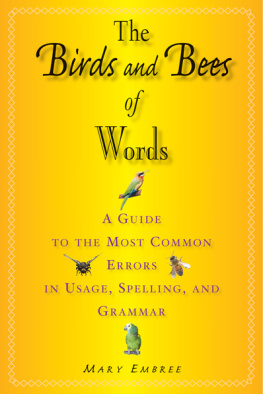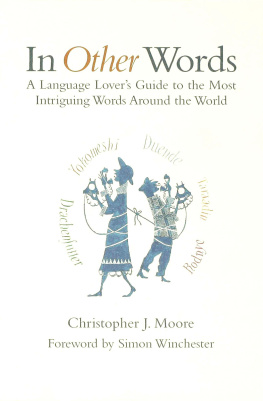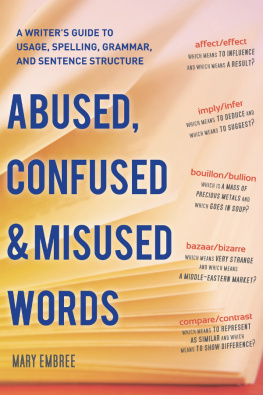
 Acknowledgements I would like to thank Dr. Diane Armstrong, Professor of English at Ventura College. She read the chapter on word usage and made some suggestions, all of which I accepted. This was the most difficult chapter for me to write. I hadnt thought much about parts of speech since I left school and I had forgotten most of the rules. Dr.
Acknowledgements I would like to thank Dr. Diane Armstrong, Professor of English at Ventura College. She read the chapter on word usage and made some suggestions, all of which I accepted. This was the most difficult chapter for me to write. I hadnt thought much about parts of speech since I left school and I had forgotten most of the rules. Dr.
Armstrong set me straight. 2007 Mary Embree All rights reserved. Copyright under Berne Copyright Convention, Universal Copyright Convention, and Pan-American Copyright Convention. No part of this book may be reproduced, stored in a retrieval system, or transmitted in any form, or by any means, electronic, mechanical, photocopying, recording, or otherwise, without prior permission of the publisher. 11 10 09 08 07 5 4 3 2 1 Published by Allworth Press
An imprint of Allworth Communications, Inc.
10 East 23rd Street, New York, NY 10010 Cover design by Derek Bacchus
Interior design by Robin Black, www.blackbirdcreative.biz
Page composition/typography by Integra Software Services, Pvt., Ltd., Pondicherry, India Library of Congress Cataloging-in-Publication Data Embree, Mary
The birds and the bees of words : a guide to the most common errors in usage, spelling,
and grammar / Mary Embree.
p. 2. 2.
English languageErrors of usage. 3. English
languageGrammar. I. Title. PE1460.E44 2007
428dc22 2007019849 This book is dedicated to MY MOTHER, who taught me to read at age three and inspired
my lifelong love of words; MY SON JOEY FLEISCHER and MY DAUGHTER JULIE FLEISCHER, who became professional writers themselves;and MY GRANDDAUGHTER SARA ANDREAS, the shining star of the family. Contents Introduction A word fitly spoken is like apples of gold in pictures of silver. PROVERBS 25:11 BIRDS DO IT.
Bees do it. All living things do it, in some way or othereven plants. What is this irresistible urge that drives us all? I mean, in addition to the obvious. Its communication. With birds, its singing and the fluttering of wings. With bees, its flitting, dancing, and buzzing.
With plants, its chemical emissions. With apes, its grunts, calls, facial expressions, and gestures. With humans, its most of the above, and more. Its also words in all their intricate forms, inflections, and nuances. The species are not just talking among themselves. We all have dialogues with other species.
There is no doubt that all life is interconnected, as well as interdependent. The research I did on language among various species was fascinating and often surprising. It led me to give this book the title The Birds and Bees of Words. According to entomologist David G. James of Washington State University, Plants talk. Plants listen.
Scientific studies have shown that plants respond to insect attacks by emitting distress signals in the form of volatile chemicals. This emission is the language they use to warn other plants of a possible attack on them as well. Primates are the closest animal to us genetically and have many ways of transmitting information to each other, such as gestures, facial expressions, and sounds. They also have excellent vision and rely heavily on visual signals. However, these primates, whose vocal physiology is so much like ours, cannot make sounds like we do and they have never developed a spoken language. Birds must rely on their wings and tail for movement, which limits their use for signaling, so they have developed a complex language of calls and songs.
Those that spend their lives mainly in dense forests cant readily be seen and must rely more on sound to communicate with each other than do birds that live in open spaces. Calls are short, usually just one syllable, and they are used to indicate alarm, maintain contact, threaten other birds, or scold predators. Songs are longer and usually sung by males to advertise a nesting area, to establish a feeding area, or to attract a mate. Calls occur anytime; songs are usually heard in the spring and the summer. The only creatures that can realistically mimic human speech are parrots and a few other birds. Parrots can mimic other animals and many different sounds in their environment.
But only those that have been kept in the company of humans have learned to talk. And even though they are great at mimicry, they are unable to create and express concepts on their own using human language. In The Life of the Bee, written in 1901, Count Maeterlinck remarked that honeybees were so human-like and intelligent that they had a language. According to the Encyclopaedia Britannica, the ability to communicate about things outside immediate temporal and spatial contiguity, which is fundamental to speech, is found elsewhere only in the so-called language of bees. Bees were among the first scientific studies of how animals communicate. Nobel Prize winner Karl von Frisch began studying honeybees in the early 1900s, and his amazing discoveries were published in 1923.
He and many other scientists believe that their symbolic language is without match in the animal kingdom. Frisch found that bees are able to tell each other where they can find nectar through various sounds and a series of movements called bee dances. When a bee discovers a new source of food, she gathers the honey and pollen and returns to the hive so others can sample the quality of her find. She then performs various dances, accurately describing the location, distance, quality, and quantity of the nectar. The duration of the buzzing and every movement of the dance has significance. A circular dance tells the others that the food is near the hive.
A waggle dance indicates the food is farther away. The faster the rate of looping, the closer the food. The longer the buzzing, the farther away. The dances also reveal the direction in relation to the sun. Bees dance longer and more vigorously when the food source is very rich. Nectar is not the only thing bees talk about.
They use their dance to indicate water sources and to recruit scout bees to find a new nest site. The detailed information contained in the bees dancing and buzzing makes it the only known abstract language in nature other than human language. We humans have the most versatile and complex form of language, and what no other species on earth possesses: words. Whether were teaching, conducting business, or having a personal conversation, using appropriate words is essential for clarity. Words have the power to ignite anger, inflame passions, and destroy relationships. But they also have the power to pacify, console, educate, amuse, and express love.
There are many different human languages in the world, which means that we do not have a common base of words to work with. The wide variations of meaning in our vocabularies create the challenge of communicating clearly with people whose language is not the only dividing factor. Their culture, philosophy, and belief systems are not like our own. Ludwig Wittgenstein said, If we spoke a different language, we would perceive a somewhat different world. He also said, The limits of my language mean the limits of my world. Using an inappropriate word can cause misunderstandings, and misunderstandings can have serious consequences.
If we want to reach our audience, we need to simplify our language and adapt our words to our readers repertoire. Simplification also makes for better writing. The German philosopher Arthur Schopenhauer said, Writers should use common words to say uncommon things. When computers and the Internet became a major part of our everyday lives, communication moved into the fast lane. We no longer have time to waste addressing and stamping envelopes. E-mail has become a quick way to communicate and, as we dash off messages, we tend to get sloppy.
Next page













 Acknowledgements I would like to thank Dr. Diane Armstrong, Professor of English at Ventura College. She read the chapter on word usage and made some suggestions, all of which I accepted. This was the most difficult chapter for me to write. I hadnt thought much about parts of speech since I left school and I had forgotten most of the rules. Dr.
Acknowledgements I would like to thank Dr. Diane Armstrong, Professor of English at Ventura College. She read the chapter on word usage and made some suggestions, all of which I accepted. This was the most difficult chapter for me to write. I hadnt thought much about parts of speech since I left school and I had forgotten most of the rules. Dr.